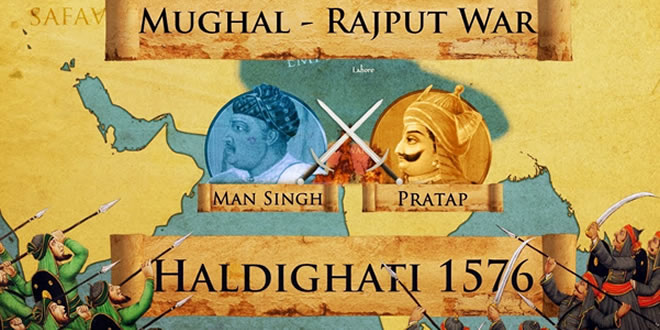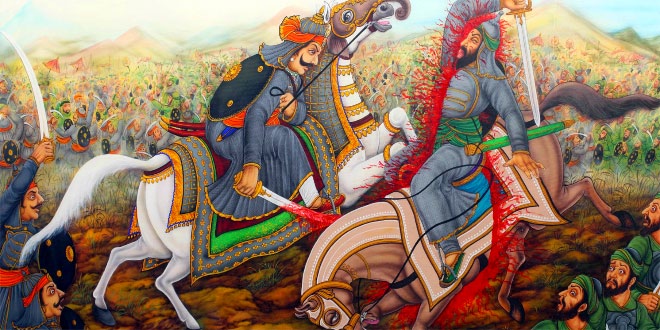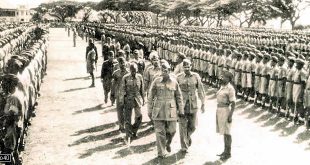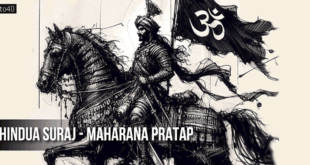Maharana Pratap: The battle of Haldighati – Mewar is a region that defies conventional ideas and modern beliefs. Its people are proud. People may wonder why so, but a peek into Mewar’s history and a visit to the area will give all the answers one needs. This land in the Aravalli range of Rajasthan has seen people who gladly embraced death to protect the honour of their land, women who preferred stepping into blazing infernos instead of surrendering to invaders and kings who defended its sovereignty till the last drop of their blood. Mewar gave birth to legends like Rani Padmini and warriors like Maharana Pratap.
Maharana Pratap: The battle of Haldighati
Years ago, while touring through the region, one of my friends asked casually the driver cum guide, “why do you people take so much pride in being from Mewar?” His answer came with a sombre smile, “because we remained free”. It took me some time to realize the profoundness of his words. Indeed, Mewar was the only region which never gave up, it kept fighting back relentlessly.
Maharana Pratap: A lion amongst men and the battle of Haldighati
We all are very familiar with the saga of Rani Padmini’s Jauhar and Allauddin Khilji’s victory over Chittorgarh. But few realize the fact that the story did not end there. Khilji seized Chittorgarh in 1303. A distant kin of the slain ruler Rawal Ratan Singh named Hamir Singh regained control after killing Maldeva, the proxy under whom Khilji has left Chittor. With Hamir Singh’s ascension in 1326, the first chapter in the glorious saga of Sisodiya dynasty was written. Hamir was the first ruler to take the title of Rana (Prime Minister). The Sisodiya dynasty submits to Eklingji as the supreme ruler of Mewar and serves under his name. With Hamir began a dynasty that is unmatched with any other in the history of India. In was in this line of valiant kings that Maharana Pratap was born in 1540.
Rana Pratap ascended the throne of Mewar in 1572. Sadly his ascension did not happen in Chittorgarh, for the fort was under seize by Akbar’s Mughal army since 1567 and Pratap’s father, Rana Udai Singh II had shifted his capital to Gogunda. Akbar tried a lot to sway the chieftains and leaders of Mewar towards himself, but the people recognized only their Ranas as their rulers. When Rana Pratap took the throne, he was well aware of an imminent war with the mighty Mughals. Through 1573, Akbar is believed to have sent a number of truce offers to the Maharana, but Maharana Pratap was not willing to compromise with the sovereignty of Mewar. In the meanwhile, though surrounded and outnumbered, Maharana Pratap never stopped preparing for battle.
Maharana Pratap knew that the hills of the Aravali range were his best defence. He had urged the villagers of the area to leave for the mountains so the raiding Mughal armies are strapped for food and sustenance. He befriended the tribal leaders including the Bhils and kept taking into confidence regional rulers and groups. The trade routes of the Mughals to Gujarat passed through Mewar, so Maharana started ordering raids on trading caravans. Finally, Akbar decided to engage in full frontal battle and ordered his general Man Singh of Amber to attack Maharana Pratap.
Maharana Pratap had previous information of the marching army. The Mewari troops laid waiting in the Haldighati pass near Gogunda. What happened in the few hours of 18 June 1576 has inspired countless poems, paintings and stories.
There are different opinions about the exact numbers of cavalry and infantry in the Mewari and Mughal side. But one thing all historians agree upon is that the Mewaris were severely outnumbered. Both sides had horses, elephants and archers, but the Mughals possessed a significant advantage, they had guns. The only advantage Maharana Pratap possessed was the rocky, hilly terrain that his troops were accustomed to. The battle has been immortalized in the poem by Shyamnarayan Pandey:
चढ़ चेतक पर तलवार उठा,
रखता था भूतल पानी को।
राणा प्रताप सिर काट काट,
करता था सफल जवानी को॥
The bravery of Maharana Pratap and his beloved horse has been the inspirations for many artworks, paintings and folklore in the region. One of the prominent stories says Maharana Pratap’s strength and skills were so fierce he cut down one of the Mughal commanders and his horse with a single stroke of his sword.
The battle is believed to have lasted only a few hours. Maharana Pratap’s soldiers showed exemplary courage and skills in the battle. Though there are disputed opinions about the results of the battle with a considerable number of experts believing that Maharana Pratap lost on that day, an examination of the aftermath definitely suggests otherwise.
Maharana Pratap lost many of his brave leaders and commanders that day. One of the bravest was the warrior Jhala Man who, sensing imminent danger to Maharana’s life, took his silver chhatra and rushed over to fight the Mughal army. The silver chhatra made the enemies confused and they took Jhala Man as Maharana himself. Jhala Man bought Maharana precious time to escape and take refuge in the hills.
The results of the battle of Haldighati were inconclusive. Though the Mughals did occupy Gogunda and the nearby regions, Maharana Pratap was relentless. He expertly gathered the remaining leaders, engaged the Bhils and other tribals and kept on attacking enemy camps. He led guerrilla attacks and took Mughal troops by surprise, he raided trade parties and all the while he never let Akbar rest in peace. Maharana Pratap had sworn an oath that he will not enjoy royal luxuries till he had freed Mewar from the Mughal clutches and he made good on that promise. Maharana Pratap ate from leaf-plates, slept on floors and lived in huts all through the struggle with Akbar’s army. Throughout the years, he faced lack of funds, weapons and struggled with hardships, but he never gave up. The people of Mewar never gave up. Soon he was able to take back most of the territory Akbar had occupied and the clashes continued.
Finally, Akbar shifted his focus elsewhere and Mewar saw some years of peace. Maharana Pratap had slowly regained most of Mewar and he ruled for several years in peace. In a time when almost entire northern India was under Akbar’s rule, Mewar remained as the bright, tiny drop of Hindu Pride.
Modern Indian history books have been unfair to Hindu Kings including Maharana Pratap. While the Mughals are glorified beyond reason, the relentless and often successful battles of Hindu Kings never get their deserved place in history books. Modern history books may have ignored Maharana Pratap and his predecessors, but he lives on the minds and hearts of the people of Mewar, and all Indians who take pride in their heritage. The battle of Haldighati might have been inconclusive, but when it comes to honour and valour, Mewar had the last laugh. Maharana Pratap fulfilled his oath to his motherland.
 Kids Portal For Parents India Kids Network
Kids Portal For Parents India Kids Network










One comment
Pingback: What is Haldighati? - Kids Portal For Parents